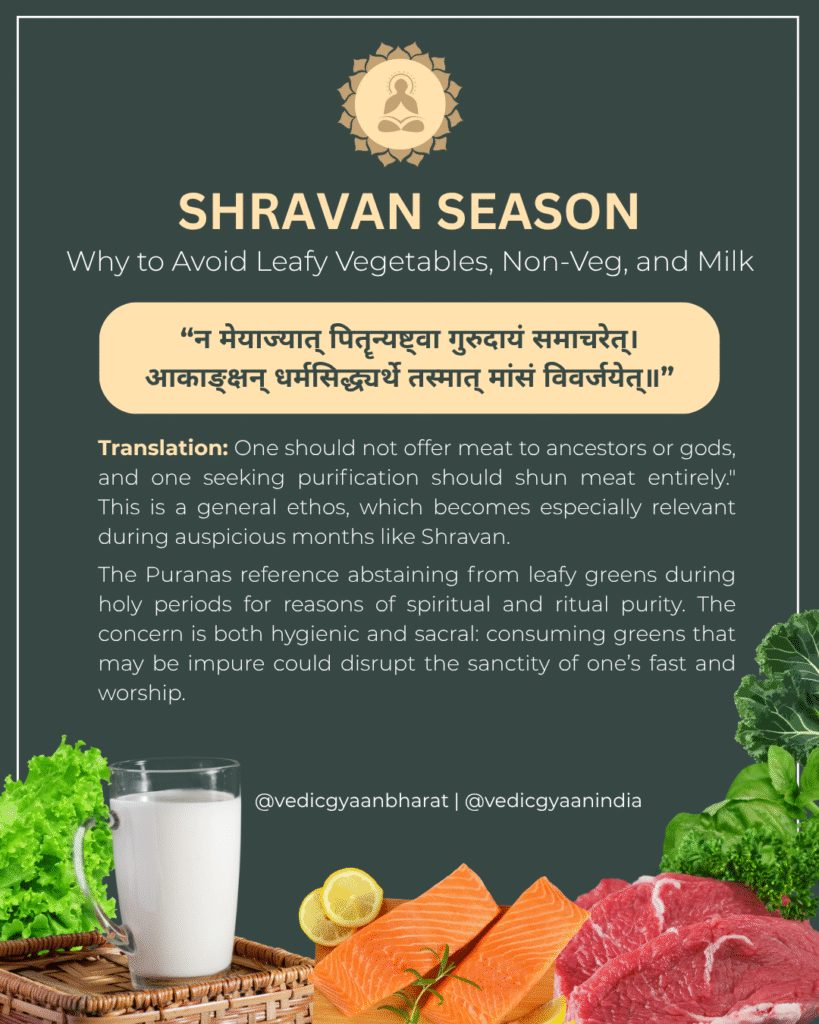Introduction
As the monsoon settles in and the sacred month of Shravan (Sawan) arrives. Millions of Hindus across India embark on fasting and adopt mindful, spiritual eating practices. This period is devoted to the worship of Lord Shiva, inner reflection, and physical purification through dietary discipline—transforming the kitchen into a tool for spiritual and bodily cleansing. But why do traditions advise against consuming green leafy vegetables, non-vegetarian foods, and milk during Shravan? Let’s explore this, blending insights from Ayurveda, science, and ancient spiritual wisdom.

The Significance of Shravan and Fasting
Shravan, marking the heart of the monsoon, is celebrated for its spiritual potency. Devotees use this time to detoxify their bodies and minds, seeking blessings through fasting, simple rituals, and strict food choices. The guiding principle is to maintain a sattvic diet—foods that are pure, fresh, and light—which, according to both Ayurveda and tradition, supports spiritual growth and well-being.
Why Avoid Green Leafy Vegetables?
Scientific Perspective:
- Contamination & Infection: The monsoon rains cause an explosion of bacteria, fungi, and parasites on green leafy vegetables such as spinach, fenugreek, and amaranth. These greens grow close to the soil, retaining mud and plenty of microscopic pests that are difficult to clean, leading to higher chances of foodborne illnesses and digestive problems during this season.
- Foodborne Diseases: Studies report a seasonal rise in outbreaks of gastrointestinal infections linked to contaminated leafy greens during humid monsoon months.
Ayurvedic View:
- Weaker Digestion (Agni): Ayurveda explains that the body’s digestive fire is naturally subdued in the monsoon, making even normally healthy foods harder to digest. Leafy vegetables are considered “heavy” and capable of promoting Kapha and Pitta imbalances, which can manifest as sluggishness or gastric upset.
Traditional Practice:
- Purity Codes: The Puranas reference abstaining from leafy greens during holy periods for reasons of spiritual and ritual purity. The concern is both hygienic and sacral: consuming greens that may be impure could disrupt the sanctity of one’s fast and worship.
Why Abstain from Non-Vegetarian Food?
Scientific Perspective:
- Spoilage Risks: High humidity and fluctuating temperatures accelerate the spoilage of fish, poultry, and meat, allowing dangerous bacteria to proliferate. The risk of food poisoning, infections, and stomach upset climbs dramatically if non-vegetarian foods aren’t handled impeccably—challenging to guarantee during the monsoon
- Breeding Season: Fish and many animals breed during monsoons. Eating non-veg foods disturbs ecological cycles and often means consuming less fresh produce.
Ayurvedic and Vedic Perspective:
- Heavy and Tamasic: Ayurveda ranks non-vegetarian food as “tamasic” (increasing inertia and dullness) and “heavy,” likely to overload compromised digestion and impede clarity of thought—contrary to the sought “sattva” (purity and clarity). The Manusmriti and other Smritis advocate non-violence (ahimsa) and purity, both supported by vegetarianism.
- Spiritual Discipline: Non-vegetarian food is believed to generate restlessness, irritability, and hinder meditation and prayer. Fasting from animal products during Shravan is both an ethical and spiritual reset, aligning diet with sacred aspiration.
Why Limit or Avoid Milk in Shravan?
Scientific Perspective:
- Pathogen Risk: Monsoon conditions expose dairy animals to damp, mud, and infected feed, increasing the chance that milk contains harmful bacteria, which may not always be destroyed by pasteurization. This can lead to allergies and gastrointestinal trouble for sensitive individuals.
Ayurvedic Rationale:
- Heavy to Digest: Ayurveda regards milk as nourishing but “heavy” in the monsoon. With weakened digestive power, unprocessed or excess dairy can cause bloating, acidity, or indigestion.
Spiritual Custom:
- Sacrificial Abstinence: Milk is used in ritual offerings (abhishekam) to Lord Shiva during Shravan. Some devotees abstain from drinking it as a mark of reverence, dedicating it entirely to worship.
Sattvic Diet in Shravan: What to Eat Instead
- Fruits, Root Vegetables, and Gourds: Sweet potatoes, bottle gourd, arbi, and tapioca are light, digestible, and traditionally encouraged for energy and hydration[1][2][3].
- Buckwheat (Kuttu), Amaranth (Rajgira), and Samak Rice: Gluten-free grains nourish without overloading the gut.
- Select Dairy: If not strictly fasting from milk, curd (probiotic), buttermilk, and ghee in moderation support gut health and are easier to digest[1].
Healthy Fasting Tips for Shravan
- Stay Hydrated: Drink plenty of water, coconut water, and avoid caffeinated or carbonated drinks.
- Balance Meals: Use nuts, seeds, and fresh fruits to maintain energy and nutrient balance.
- Spices: Use mild spices; avoid excess salt and chili to protect digestion.
- Eat Fresh: Focus on seasonal, fresh, and minimally processed foods to maximize nutrition and prana (life force)[3].
Wrapping Up: The Shravan Diet as a Time-Tested Wellness Practice
The discipline of avoiding green leafy vegetables, non-vegetarian foods, and—sometimes—milk during Shravan is built on layers of ancient wisdom and scientific sensibility. These practices:
- Protect against seasonal illnesses
- Enhance digestion and detoxification
- Elevate spiritual energy and inner clarity
By embracing the sattvic, plant-based eating recommended in Shravan, devotees experience both improved health and a profound connection to the month’s spiritual essence



